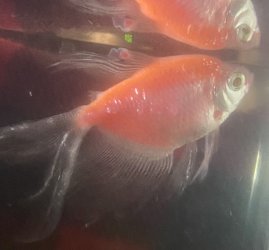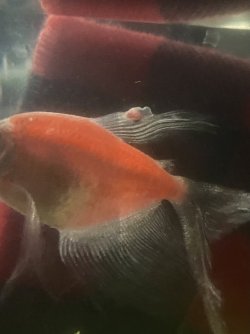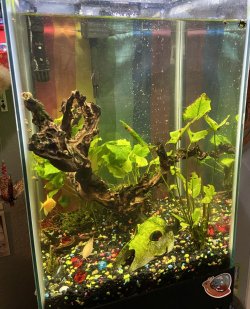Kinz
New Member
My pink glofish tetra has developed this weird bulb on their fin not too long ago, and from looking it up and testing my tank (PH, Ammonia, Nitrate, and Nitrite, which all came out normal/nonexistent — I’ve had this tank for a few years now), I assumed it was too much oxygen. I had been letting my filter bubble so oxygen would get to the bottom feeders (tank is tall rather than wide) but lately my plants have kinda taken off…
I thought it was getting better after I raised the water level to stop the bubbling, but the base of this bulb on their fin started getting white growth — which again, I wasn’t too worried about. I’ve asked about that before and was told that was pretty normal, and they get it a lot. It’s never been like an infection or anything, just scar tissue or calcium deposits. All in all, only my long finned fish (all glo tetras) ever had an issue and it never spread or got worse/super concerning. Obviously I still keep an eye on it when I see it, but so far, it’s always consistently disappeared after a week or so.
This time, though, I was looking at the pink tetra the other day, and noticed little red specks within that white build up, and that’s when alarm bells started going off. I put them in a small tank I had handy with the same water and a heater, and have been watching my other fish like a hawk, alongside the injured one. Now I’m looking at the pink one today, and the injury(?) just looks a lot worse. I’m not really sure what’s happening, if it’s a tumor, or hopefully something I can treat? So far I’ve just been using Stress Coat and Pimafix in both tanks cuz it’s all I have...
It’s been a few days, and no other fish shows signs of this issue. Google has given me nothing, so any advice would be appreciated! I am going to bed right now, so if I don’t reply for a while I promise I’ll swoop around soon.
(I tried taking the best pics I could, the fish is a little jumpy…)
I thought it was getting better after I raised the water level to stop the bubbling, but the base of this bulb on their fin started getting white growth — which again, I wasn’t too worried about. I’ve asked about that before and was told that was pretty normal, and they get it a lot. It’s never been like an infection or anything, just scar tissue or calcium deposits. All in all, only my long finned fish (all glo tetras) ever had an issue and it never spread or got worse/super concerning. Obviously I still keep an eye on it when I see it, but so far, it’s always consistently disappeared after a week or so.
This time, though, I was looking at the pink tetra the other day, and noticed little red specks within that white build up, and that’s when alarm bells started going off. I put them in a small tank I had handy with the same water and a heater, and have been watching my other fish like a hawk, alongside the injured one. Now I’m looking at the pink one today, and the injury(?) just looks a lot worse. I’m not really sure what’s happening, if it’s a tumor, or hopefully something I can treat? So far I’ve just been using Stress Coat and Pimafix in both tanks cuz it’s all I have...
It’s been a few days, and no other fish shows signs of this issue. Google has given me nothing, so any advice would be appreciated! I am going to bed right now, so if I don’t reply for a while I promise I’ll swoop around soon.
(I tried taking the best pics I could, the fish is a little jumpy…)

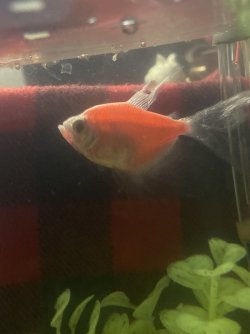
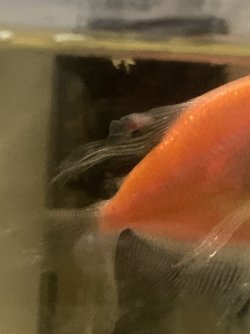
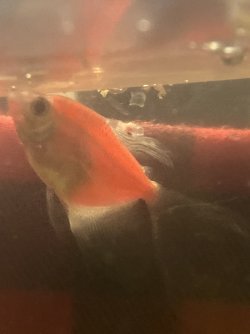
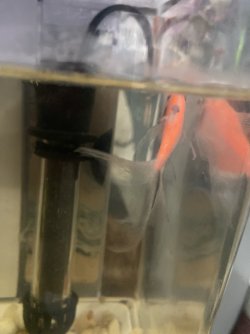

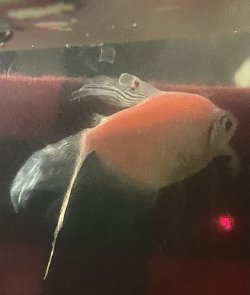
 No one else seems to have any issue, so I kinda wonder if it was just getting into semi open wounds maybe?
No one else seems to have any issue, so I kinda wonder if it was just getting into semi open wounds maybe?